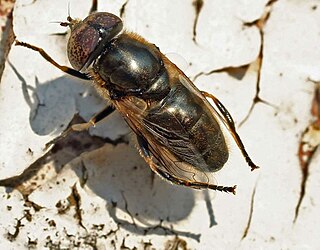
Eristalis nemorum is a species of hoverfly. It is found in the Palearctic and in the Nearctic.

Helophilus trivittatus is a species of Palearctic hoverfly.

Helophilus hybridus is a hoverfly. It is a Palearctic species.

Eristalinus sepulchralis is a European species of hoverfly. The species are brownish-white from a close up, and look like a wasp. From a distance though, they are yellowish-black coloured, and look like a bumble bee. The species can be found throughout Europe in the Baltic states, North Europe, Central, Southern and Western Europe and across the Palaearctic to Kamchatka, Japan, China and India. Finland, Great Britain, Hungary, Ireland, Norway, and the Netherlands.

Criorhina berberina is a species of hoverfly. It is found in the Palaearctic from Fennoscandia South to Iberia and Italy. Ireland eastwards through Europe into Turkey and European Russia . C. berberina is a bumblebee mimic. The body has uniformly long dense pubescence, obscuring the ground-colour. There are two forms one with the pubescence more or less extensively blackish, one in which it is entirely yellow or tawny. Criorhina differ from other bumblebee mimics - Mallota, Arctophila, Pocota and Brachypalpus by the form of their antennae: the first segments are thin and form a stalk, the third segment is shorter than it is wide. In Criorhina, the face projects downwards, in contrast to Pocota and Brachypalpus.

Neoascia podagrica is a species of hoverfly.

Orthonevra nobilis is a species of hoverfly.

Eristalis abusiva is a European species of hoverfly. It is similar to Eristalis arbustorum.

Ferdinandea cuprea is a European species of hoverfly notable for its brassy abdomen. The larvae have been found in sap from trunk damage on oak and ash.

Melanogaster hirtella is a European species of hoverfly.

Lejogaster metallina is a Palearctic species of hoverfly.

Parasyrphus vittiger is a species of hoverfly, from the family Syrphidae, in the order Diptera.

Anasimyia lineata is a Palaearctic species of hoverfly.

Anasimyia transfuga is a Palearctic species of hoverfly.

Parhelophilus consimilis is a Palearctic hoverfly.
Melangyna arctica is a Holarctic species of hoverfly.

Melangyna quadrimaculata is a European species of hoverfly.

Dasysyrphus pinastri is a species of hoverfly found in Europe.

Neoascia meticulosa is a species of hoverfly.

Epistrophe nitidicollis is a European and North American species of hoverfly.



















